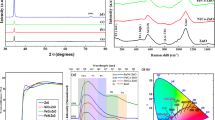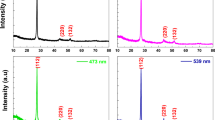Abstract
Germanium nanostructures are prepared by electrochemical etching of n-type Sb-doped (100) oriented germanium (Ge) substrates with resistivity of 0.01 Ω cm. Ge substrates are etched in an electrochemical double cell containing hydrofluoric acid and ethanol solution at room temperature. Although the use of illumination source is essential for etching of an n-type semiconductor material, the influence of illumination source type on the germanium surface morphology has not yet been investigated. In this work, the illumination effect is studied by halogen lamp, white LED, 470- and 405-nm pulsed diode laser. It is demonstrated that different Ge surface morphologies such as nanocone, nanorod, nanoplate and nanopyramid are obtained using different illumination source. The current density, anodization time and pulsed laser power density effects on Ge nanopyramid are investigated in order to optimize anodization conditions. The most uniform and continuous Ge nanopyramid array is obtained at the current density of 30 mA/cm2 for 45 min under cathode side illumination with 470-nm pulsed diode laser. It is observed that the nanostructured Ge surfaces exhibit a broad photoluminescence band between 400 and 650 nm. Time-resolved fluorescence spectroscopy studies of electron transfer process between BODIPY dye and Ge nanostructures are reported. The obtained fluorescence lifetime data are analyzed in the light of the Marcus electron transfer theory to determine the conduction band energy level of nanostructured germanium substrates.













Similar content being viewed by others
References
Oh J, Yuan HC, Branz HM (2012) An 18.2% efficient black silicon solar cell achieved through control of carrier recombination in nanostructures. Nat Nanotechnol 7:743–748
Sainato M, Strambini LM, Rella S, Mazzotta E, Barillaro G (2015) Sub-parts per million NO2 chemi-transistor sensors based on composite porous silicon/gold nanostructures prepared by metal assisted etching. ACS Appl Mater Interfaces 7:7136–7145
Chiappini C, Rosa ED, Martinez JO, Liu X, Steele J, Stevens MM, Tasciotti E (2015) Biodegradable silicon nanoneedles delivering nucleic acids intra cellularly induce localized in vivo neovascularization. Nat Mater 14:532–539
Cunin F, Schmedake TA, Link JR, Li YY, Koh J, Bhatia SN, Sailor MJ (2002) Biomolecular screening with encoded porous-silicon photonic crystals. Nat Mater 1:39–41
Ng WL, Lourenço MA, Gwilliam RM, Ledain S, Shao G, Homewood KP (2001) An efficient room-temperature silicon-based light-emitting diode. Nature 410:192–194
Wang W, Favors Z, Ionescu R, Ye R, Bay HH, Ozkan M, Ozkan CS (2015) Monodisperse porous silicon spheres as anode materials for lithium ion batteries. Sci Rep 5:8781–8786
Kumar RR, Rao KN, Phani AR (2011) Growth and characterization of germanium nanowires on a flexible aluminum substrate by electron beam evaporation. Appl Nanosci 1(4):211–217
Kolibal M, Matlocha T, Vystavel T, Sikola T (2011) Low energy focused ion beam milling of silicon and germanium nanostructures. Nanotechnology 22:105304–105311
Pchelyakova OP, Bolkhovityanova YB, Dvurechenskiia AV, Nikiforova AI, Yakimova AI, Voigtlander B (2015) Molecular beam epitaxy of silicon–germanium nanostructures. Thin Solid Films 367:75–84
Dailey JW, Taraci J, Clement T, Smith DJ, Drucker J, Picraux ST (2004) Vapor liquid solid growth of germanium nanostructures on silicon. J Appl Phys 96:7556–7567
Seo MA, Kim DS, Kim HS, Choi DS, Jeoung SC (2006) Formation of photoluminescent germanium nanostructures by femtosecond laser processing on bulk germanium: role of ambient gases. Opt Express 14(11):4908–4914
Flamand G, Poortmans J, Dessein K (2005) Formation of porous Ge using HF-based electrolytes. Phys Status Solidi (c) 2:3243–3247
Fang C, Föll H, Carstensen J (2006) Electrochemical pore etching in germanium. J Electroanal Chem 589:259–288
Kartopu G, Sapelkin AV, Karavanskii VA, Serincan U, Turan R (2008) Structural and optical properties of porous nanocrystalline Ge. J Appl Phys 103:113518–113524
Rojas EG, Hensen J, Carstensen J, Föll H, Brendel R (2011) Porous germanium layers by electrochemical etching for layer transfer processes of high-efficiency multi-junction solar cells. ECS Trans 33(17):95–102
Tutashkonkoa S, Boucherif A, Nychyporuk T, Kaminski-Cachopo A, Arès R, Lemiti M, Aimez V (2013) Mesoporous germanium formed by bipolar electrochemical etching. Electrochim Acta 88:256–262
Tutashkonko S, Alekseev S, Nychyporuk T (2015) Nanoscale morphology tuning of mesoporous Ge: electrochemical mechanisms. Electrochim Acta 180:545–554
Liang D, Huo Y, Kang Y, Wang KX, Gu A, Tan M, Yu Z, Li S, Jia J, Bao X, Wang S, Yao Y, Wong HSP, Fan S, Cui Y, Harris JS (2012) Optical absorption enhancement in freestanding GaAs thin film nanopyramid arrays. Adv Energy Mater 2:1254–1260
Han Q, Fu Y, Jin L, Zhao J, Xu Z, Fang F, Gao J, Yu W (2015) Germanium nanopyramid arrays showing near 100% absorption in the visible regime. Nano Res 8(7):2216–2222
Riedel M, Müller B, Wintermantel E (2001) Protein adsorption and monocyte activation on germanium nanopyramids. Biomaterials 22:2307–2316
Li X, Yang Z, Fu Y, Qiao L, Li D, Yue H, He D (2015) Germanium anode with excellent lithium storage performance in a germanium/lithium–cobalt oxide lithium-ion battery. ACS Nano 9(2):1858–1867
Hwang J, Jo C, Kim MG, Chun J, Lim E, Kim S, Jeong S, Kim Y, Lee J (2015) Mesoporous Ge/GeO2/carbon lithium-ion battery anodes with high capacity and high reversibility. ACS Nano 9(5):5299–5309
Gao YQ, Marcus RA (2000) On the theory of electron transfer reactions at semiconductor/liquid interfaces. II. A free electron model. J Chem Phys 113:6351–6359
Williams RM, Koeberg M, Lawson JM, An YZ, Rubin Y, Paddon-Row MN, Verhoeven JW (1996) Photoinduced electron transfer to C60 across extended 3- and 11-bond hydrocarbon bridges: creation of a long-lived charge-separated state. J Org Chem 61:5055–5062
Darius K, Michael SF, Harry BG, Jay RW (2001) Electron transfer dynamics in nanocrystalline titanium dioxide solar cells sensitized with ruthenium or osmium polypyridyl complexes. J Phys Chem B 105:392–403
Vyas AD, Rana VA, Gadani DH (2011) Dielectric properties of mixtures of some rigid polar molecules with some primary. Indian J Pure Appl Phys 49:277–283
Rehm D, Weller A (1970) Kinetics of fluorescence quenching by electron and H-atom transfer. Isr J Chem 8:259–271
Nepomnyashchii AB, Bard AJ (2012) Electrochemistry and electrogenerated chemiluminescence of BODIPY dyes. Acc Chem Res 45(11):1844–1853
Porter LA, Choi HC, Ribbe AE, Buriak JM (2002) Controlled electroless deposition of noble metal nanoparticle films on germanium surfaces. Nano Lett 2:1067–1071
Tvrdy K, Frantsuzovc PA, Kamat PV (2011) Photoinduced electron transfer from semiconductor quantum dots to metal oxide nanoparticles. PNAS 108:29–34
Acknowledgements
This work was supported by TUBITAK under Grant Number 114F451 and Karamanoğlu Mehmetbey University Research Fund under Grant Number 16-M-15.
Author information
Authors and Affiliations
Corresponding author
Rights and permissions
About this article
Cite this article
Acikgoz, S., Yungevis, H., Özünal, E. et al. Low-cost, fast and easy production of germanium nanostructures and interfacial electron transfer dynamics of BODIPY–germanium nanostructure system. J Mater Sci 52, 13149–13162 (2017). https://doi.org/10.1007/s10853-017-1434-6
Received:
Accepted:
Published:
Issue Date:
DOI: https://doi.org/10.1007/s10853-017-1434-6




